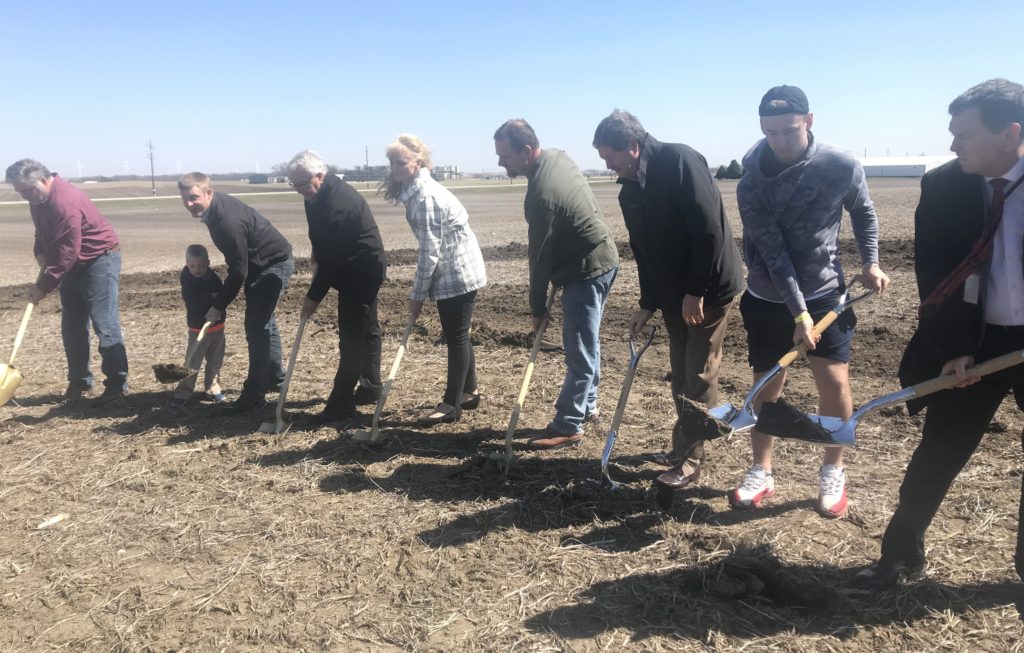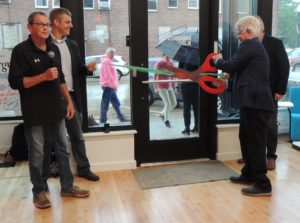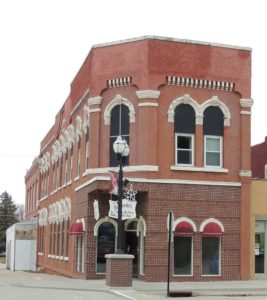The top stories in Greene County in 2019 involved bricks and mortar or paying for bricks and mortar. All are continuations of efforts started previously.
Ground was broken for the regional career academy and new Greene County High School April 15. About 75 persons attended the groundbreaking, including community members, school staff and students, elected officials, and professionals involved with the project.
The weather was pleasant that day and superintendent Tim Christensen was optimistic that walls would start going up in June. The wet spring slowed site preparation, though, and rain during the early summer added to the problem. Interior masonry walls were started in early June, but the precast concrete panel exterior walls of the career academy weren’t delivered until early July because the delivery trucks were too heavy for the abundant mud at the site.

Owner’s representative Sam Harding told the school board in June the project was “officially getting behind.” He reported in August the project was two weeks behind and seven days were added to the contract time. The date for substantial completion of the career academy, classroom wing, and commons area was set ford Aug. 1. The gymnasium was set for completion by Aug. 15, and the auditorium for Oct. 1.
By September the project was only one week behind. Most of the floor of the career academy had been poured and work on the roof was set to being yet that month. In October, Christensen reported the project was “slightly behind.” Harding reported Nov. 18 “the structure is starting to come along.”
A change order in December put the project back on track, with completion of the entire project except for the auditorium targeted for Aug. 1. The change order replaced a load bearing masonry wall on the west side of the music suite (immediately to the west of the auditorium) with a precast concrete wall. The project as of the end of December was still within the original budget of $34.7 million.
Planning also started for the repurposing of the current high school as a middle school. Enough of the work will be done that middle school students will begin the 2020-21 school year in their new building.
 In a related story, the Greene County supervisors took on bonded indebtedness for the first time in many, many years. General obligation bonds in the amount of $4,755,000 were issued Dec. 5 for the purpose of paying for the regional career academy. The academy will be owned by Greene County Schools and operated by Iowa Central Community College.
In a related story, the Greene County supervisors took on bonded indebtedness for the first time in many, many years. General obligation bonds in the amount of $4,755,000 were issued Dec. 5 for the purpose of paying for the regional career academy. The academy will be owned by Greene County Schools and operated by Iowa Central Community College.
The bonds will be repaid using revenue from tax increment financing (TIF) against Mid-American Energy’s Beaver Creek Wind Park. Staff in the auditor’s and assessor’s office spent countless hours during the year creating the needed urban renewal district need to use TIF.
Brick and mortar projects continued in downtown Jefferson, including completion of the renovation of the old Odd Fellows hall into The Forge, home of Pillar Technologies, now owned by Accenture.

A gala grand opening was held Sept. 7, with a free community barbecue, tours of The Forge, and a program with guest speakers including Gov Kim Reynolds, Linc Kroeger of Accenture, and Congressman Ro Khanna, who represents California’s 17th Congressional district, home of the Silicon Valley. Khanna is a national leader in rural revitalization, advocating for tech industry jobs in rural America.
Approval of the bond issue for the career academy/high school project was a prerequisite for Pillar Technology to open a worksite in Jefferson, and the promise of Pillar offering training in computer software development in Jefferson was an incentive for voters to approve the issue.
Jefferson and Greene County gained national attention for its efforts to create a “Silicon Prairie” and to become a model that can be replicated in other rural locations.
The city of Jefferson, with building and zoning officer Nick Sorensen taking the lead, continued work to rehabilitate three city-owned buildings. None of the projects were completed during the year, and the city council purchased two more downtown buildings late in the year.
Sorensen reported to the council in November that work on 200 E. State St in nearly finished. Heartland Bank will rent the west portion of the building as soon as it’s ready, with plans to open a branch there and then move to new construction on N. Elm St.
Work on 205 N. Wilson Ave, the first building the city acquired, has reached a cost of $150,000. Much work has been done on the interior, and just recently storefront glass was installed. Work at 204 N. Wilson, the former Pizza Ranch, was slowed by the need for structural beams in the ceiling; that was accomplished in November.

The city purchased 107 N. Chestnut St as part of a real estate deal to get the owner to repair the roof on another building he owns – 106 E. State St. The building on Chestnut St also needed roof work. Sorensen expects work on that building to be finished in 2020.
The final building the city purchases is at 100 E. State St, the home of Angie’s Tea Garden. The popular restaurant was forced to close in February when pipes in an upstairs apartment burst and flooded the building, making it unsafe to occupy.
The city is having the needed repairs done and will then sell it to Why Not Us?, a women’s collective that pooled resources and formed a limited liability corporation to purchase the building. Angie Peterson has agreed to operate the Tea Garden again once the building is ready.
On a much smaller scale and with only private funds, the Greene County Christian Action Resource Center purchased and renovated the former Clark Plumbing & Heating building at 1006 N. Vine St as a replacement for its much smaller building on E. Harrison St. The new location was dedicated Aug. 25.
A bricks and mortar project that hasn’t fared well is the proposed new animal shelter. Don Orris and a team of volunteers spent the year writing grant applications and fundraising, but they’re still less than half way to securing the $1.1 million needed for the project. The city of Jefferson received a $34,000 grant from the USDA for equipment. That grant, and some other grants received, will revert back to the grantors if the project isn’t completed in a timely manner.
While that project is foundering, the Greene County Early Learning Center board in November announced plans to build a new center in its current location, the corner of S. Vine and W. Madison Sts. Cost of the new building is estimated at $2.9 million. Fundraising will begin in 2020. Bids for the project won’t be let until funding is secured.
Not all efforts during the year were on construction. Dedicated volunteers in Scranton and Grand Junction planned and hosted sesquicentennial celebrations, with Scranton’s being in June and Grand Junction’s being in August. Rippey volunteers are already at work planning the Rippey sesquicentennial for August 2020.
Greene County passed the 100-mark on the number of concentrated animal feeding operations (CAFOs). Intense lobbying during the permitting process of the 99th CAFO, which is owned and operated by county supervisor Peter Bardole, his brother Tim, his father Roy and his nephew Schyler, led to the supervisors sending a letter to Gov Kim Reynolds, Rep Phil Thompson, and Sen Jerry Behn asking that a blue ribbon committee be formed to look at ways to update the master matrix used to evaluation construction permit applications.
On the horizon – A highlight of 2020 will be completion of the regional career academy and Greene County High School. The start of the 2020-21 school year will find students and teachers in their new environs, whether that be the new high school or the current high school repurposed for middle school use.
Heavy equipment will finally move on a project that’s been in the dreaming/planning stages for many years. Work will begin in the spring to relocate 243rd St east of Jefferson, a preliminary step of extending the runway at the Jefferson municipal airport. The project received full finding from the Federal Aviation Administration. Total cost of moving the road and extending the runway is $2.35 million.
